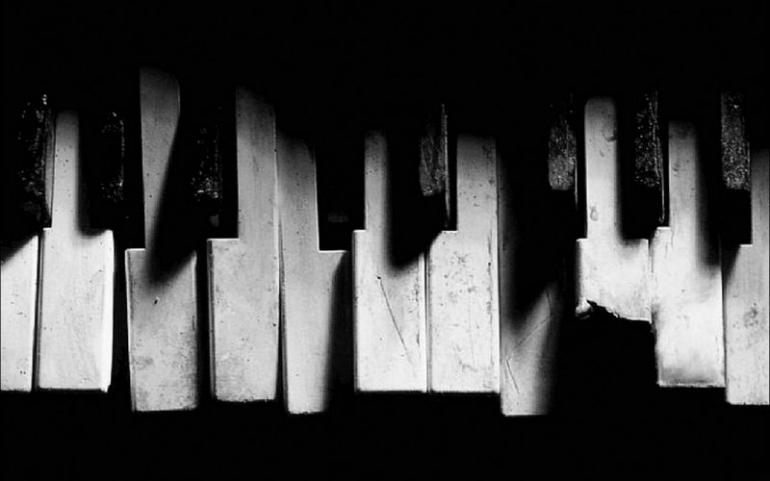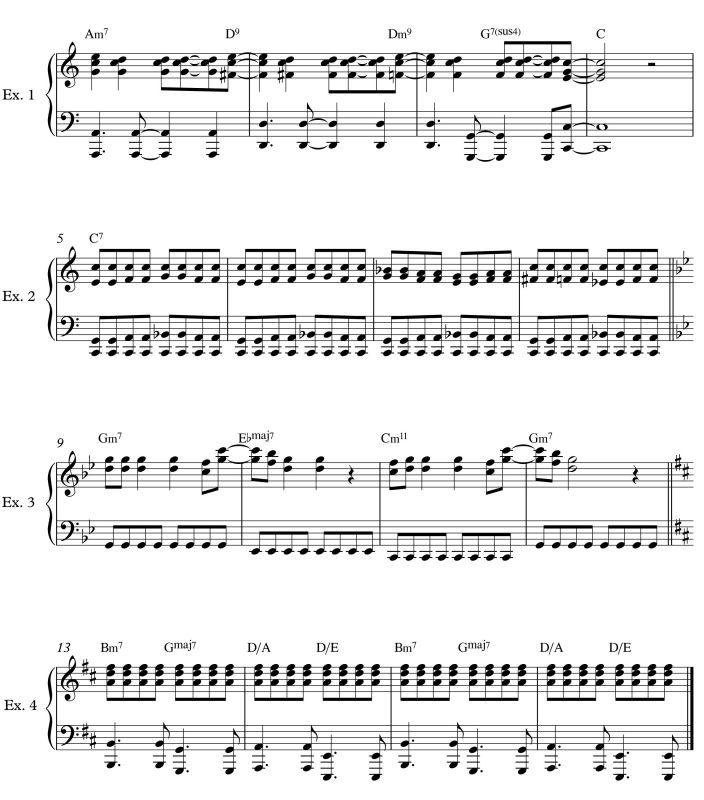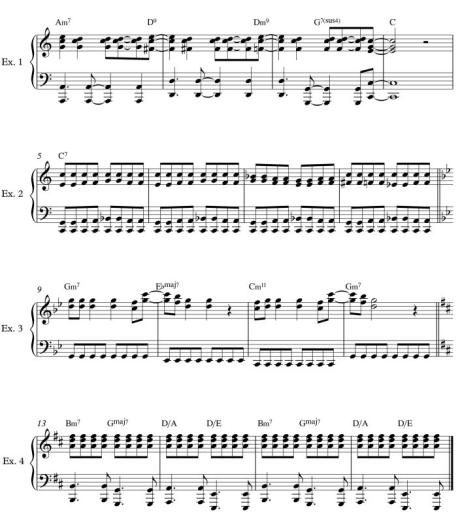Rockové klávesy - Zabijácké harmonie v rocku

Killer rock keyboard chord progressions
Hello readers! This month I want to talk a little about constructing killer rock piano parts over common chord progressions. Most of the harmony in rock music, as well as most estern music after Bach, comes from harmonizing the notes of a major or minor scale in thirds. Even though many tunes follow a very predictable progression of harmony, It's very common these days in modern pop and rock music for the harmony to quickly modulate to a different key. To further confuse the issue, many power chords on guitar have no third making the tonality even more confusing to study. Still, major and minor diatonic (meaning coming from a scale) harmony rules are a good place to start when analyzing any chord progression.
Roman numeral analysis of harmonic function
When talking about chords in a piece of music, it’s common to refer to the diatonic chords with Roman numerals corresponding to their scale degree in the scale. Take the C major scale, for example (C, D, E, F, G, A, B, C). If we stack this scale in diatonic thirds with all the notes staying in the parent scale of C major, we have these triads spelled from the bottom up with the C being the note middle C on a piano. Notice that the upper and lower case of the numeral indicates whether the chord is major or minor
I: C E G
ii: D F A
iii: E G B
IV: F A C
V: G B D
vi: A C E
vii-dim: B D F
For the most part, if a tune is in a major key, the chords will follow this format. For example, the vii chord is likely to be some sort of diminished chord. These days, however, there are increasingly more songs containing chords that don’t follow the diatonic harmony so strictly, so don't be shocked if you see unusual chords in a progression. Here is the Roman numeral reductions of the C Dorian scale so you can see how the harmony acts differently in a minor key. In C dorian this would be the scale and harmony; C, D, Eb, F, G, A, Bb, C
i: C Eb G
ii: D F A
b-III: Eb G Bb
IV: F A C
v: G Bb D
vi-dim: A C Eb
b-VII: Bb D F
Notice that some of the chords have become of a different quality because of the way the scale behaves. An interesting device some writers use is to borrow a minor chord from the dorian harmony in a major chord progression and vice versa. The Beatles are a great band to check out for tightly structured harmony and great voice leading with unusual chords and modulations.
When coming up with your own piano parts, try to find common tones in your chords so the harmony moves efficiently from chord to chord. Using our new knowledge of diatonic harmony, lets think of a few cool rock piano parts over some common chord progressions. In these exercises, the right hand part will play some kind of hypnotic rhythmic pattern with notes that “work” over the whole chord progression. As long as you are picking notes from your scales your diatonic chord progression comes from, you can never go wrong! Let’s look at a few exercises to get the flavor:
Example 1
This first example is very influenced by the song Saturday in the Park by the American rock band, Chicago. Notice how the chords in the right hand have a very tight voice leading, or smooth motion of the inner voices as the chords progress. The top two notes of the chords move just by a step creating a suspended sound while the lower voice of the right hand and bass line outline the changing harmony. The left hand octave stabs occur on syncopated beats to create a driving rhythm against the right hand part. Notice that we get a great A minor 7th voicing by dropping the root a step to the G in bar 1, beat 1, and that the D minor 9th voicing in bar 2 beat 4+ is really a root position F maj 7th voicing a minor third above the root of D; in this instance without the 3rd, A. If we were to analyze the harmony with Roman numerals, we would have: VI7 - II9 - II7 - V7sus - I in the key of C. Notice the D chord appears both as a major and minor chord. When you start to learn chord progressions with the Roman numeral system, It becomes easy to transpose to any key because you are not relying on letter names of chords, you are thinking more about harmonic function.
Example 2
This is a blues based example in C and has the static harmony of just one chord. Even though we stay on one chord here, I want to show you that you can always create a little inner motion to keep the part interesting. This approach works great over earlier rock styles from the 60’s. Take a look at Example 2, the left hand borrows a common boogie-woogie bass pattern as the right hand mirrors the part with thirds that fill in the harmony. In bar 3, I change the pattern to thirds in the right hand that descend in direction. Bar 4 uses notes from the C blues scale (C, Eb, F, F#, G, Bb, C) in the inner voice of the right hand part.
Example 3
The right hand part in Example 3 is made up entirely of notes from the G minor pentatonic scale (G, Bb, C, D, F, G) that are voiced in fourth intervals. The left hand part plays a driving 8th note bass line coming from the harmony of the G natural minor scale (G, A, Bb, C, D , Eb, F, G). When you can play the exercise well, start trying to improvise over the chords using the G natural minor scale. This harmony can be analyzed as follows: i7 - bVI7 - iv11 - I7

Example 4
Example 4 expands on the idea from the previous example. In the right hand, we have a 2nd inversion D major triad that stays exactly where it is for the whole example. A syncopated octave bass line moves underneath in a dotted quarter rock rhythm. Because all the notes in the example are from the same parent scale of G major (G, A, B, C, D, E, F#, G), the triad makes great sounding extensions to the chords as the harmony moves underneath. The “A” note over the G Maj 7 chord creates a nice 9th tension and the D/E implies a dominant seventh sound associated with Fusion music. This harmony in Roman numerals would be: ||: iii7 - I7 - V/ii - V/vi :||
Fráze a hudební termíny:
Chord progression: Sled akordů či harmonická sekvence.
Modulate: Modulace v užším slova smyslu znamená přechod z jedné tóniny do druhé pomocí průchodných tónů či akordů. Pokud skladba do jiné tóniny jednoduše „skočí“, v pravém slova smyslu se o modulaci nejedná, přestože se často i taková změna nepřesně tímto slovem označuje.
Power chord: Akord, který obsahuje kromě tóniky ještě kvintu a oktávu. Někteří čeští muzikanti mu říkají „vidle“. Je pozoruhodný tím, že neobsahuje tercii, tudíž není z podstaty ani durový, ani mollový.
Diatonic: Diatonická stupnice je taková, v které jsou každé dva sousední tóny vzdálené buď půltón nebo celý tón. Mám-li být konkrétnější, diatonická stupnice obsahuje dva půltónové intervaly, ostatní stupně jsou vzdálené celý tón. Ony dvě malé sekundy jsou od sebe vždy odděleny dvěma nebo třemi velkými sekundami, jednoduše proto, aby byly při hraní ve více oktávách od sebe co nejvzdálenější. Zjednodušeně sem patří „klasická“ durová a mollová stupnice a jejich mody.
Stack in thirds: Skládat nad sebe jednu tercii za druhou (malou či velkou): hlavní princip, na kterém je založena naše západní hudba...
Triad: Už jsme na tento termín narazili, ale pro jistotu: Jedná se o kvintakord, tedy souzvuk obsahující tóniku, tercii a kvintu. Tercie může být velká (durová) nebo malá (mollová), zatímco kvinta může být čistá, zmenšená nebo zvětšená. Vzdálenost mezi sousedními tóny kvintakordu je vždy buď malá nebo velká tercie.
Upper and lower case: Malá a velká písmena. Ne snad, že by se jednalo o hudební termín, ale pro zápis akordů je to důležité.
Tight voice leading: Vedení hlasů, ve kterém jsou tóny blízko u sebe.
Suspended sound: Brian má na mysli, že vznikají „suspended chords“, tedy akordy typu sus2 či sus4. Ty vypouštějí tercii a nahrazují ji buď sekundou (sus2) nebo kvartou (sus4).
Stabs: Výrazné akcenty hrané staccato čili krátce.
Syncopated: Synkopace znamená umísťování některých tónů na „off-beaty“, tedy lehké doby. Jedná se v podstatě o zavádění nepravidelnosti do rytmu, neboli o určitou hru s posluchačovým očekáváním. Pokud například zahrajeme na začátku taktu dvě čtvrťové noty a poté osminu bezprostředně po druhé čtvrtce, jedná se o synkopaci.
Dropping the root: Např. kytaristé toto dobře znají. Dropping znamená podlaďování, takže dropping the root pak lze chápat jako nahrazení tóniky nižším tónem.
(Harmonic) extension: Takto označujeme souzvuky, které se skládají alespoň ze čtyř tónů, které vznikly jako „nadstavby“ kvintakordů. Pokud tedy ke kvintakordu přidáme další tón, vzniká „harmonic extension“, např. septakord.




